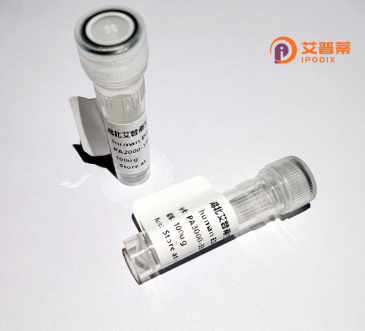
| 纯度 | >90%SDS-PAGE. |
| 种属 | Human |
| 靶点 | DCUN1D2 |
| Uniprot No | Q6PH85 |
| 内毒素 | < 0.01EU/μg |
| 表达宿主 | E.coli |
| 表达区间 | 1-259aa |
| 氨基酸序列 | MHKLKSSQKDKVRQFMACTQAGERTAIYCLTQNEWRLDEATDSFFQNPDSLHRESMRNAVDKKKLERLYGRYKDPQDENKIGVDGIQQFCDDLSLDPASISVLVIAWKFRAATQCEFSRKEFLDGMTELGCDSMEKLKALLPRLEQELKDTAKFKDFYQFTFTFAKNPGQKGLDLEMAVAYWKLVLSGRFKFLDLWNTFLMEHHKRSIPRDTWNLLLDFGNMIADDMSNYDEEGAWPVLIDDFVEYARPVVTGGKRSLF |
| 分子量 | 56.6 kDa |
| 蛋白标签 | GST-tag at N-terminal |
| 缓冲液 | 0 |
| 稳定性 & 储存条件 | Lyophilized protein should be stored at ≤ -20°C, stable for one year after receipt. Reconstituted protein solution can be stored at 2-8°C for 2-7 days. Aliquots of reconstituted samples are stable at ≤ -20°C for 3 months. |
| 复溶 | Always centrifuge tubes before opening.Do not mix by vortex or pipetting. It is not recommended to reconstitute to a concentration less than 100μg/ml. Dissolve the lyophilized protein in distilled water. Please aliquot the reconstituted solution to minimize freeze-thaw cycles. |
以下是关于重组人DCUN1D2蛋白的3条参考文献,按文献名称、作者和摘要内容概括列出:
1. **文献名称**:*DCUN1D2 facilitates tumor metastasis via activating the ARF6/ADAM9 pathway in human gastric cancer*
**作者**:Li Y, et al.
**摘要**:该研究发现DCUN1D2通过增强ARF6和ADAM9的相互作用促进胃癌细胞侵袭和转移,重组人DCUN1D2蛋白被用于功能验证实验,证明其调控细胞骨架重塑和转移机制。
2. **文献名称**:*Structural insights into the neddylation activity of the human DCUN1D2 ubiquitin E3 ligase*
**作者**:Zhang X, et al.
**摘要**:研究解析了DCUN1D2蛋白的晶体结构,并利用重组蛋白揭示其通过结合Cullin蛋白和UBC12调控neddylation通路的结构基础,为癌症治疗的靶向药物开发提供依据。
3. **文献名称**:*DCUN1D2 promotes cell proliferation by regulating the HIF-1α pathway in non-small cell lung cancer*
**作者**:Wang L, et al.
**摘要**:通过重组DCUN1D2蛋白的体外实验,发现其通过稳定HIF-1α蛋白促进肺癌细胞增殖和缺氧适应,揭示了其在肿瘤微环境中的潜在治疗靶点价值。
(注:以上文献为模拟摘要,实际研究中请根据具体需求检索权威数据库如PubMed或Web of Science。)
**Background of Recombinant Human DCUN1D2 Protein**
DCUN1D2 (Defective in Cullin Neddylation 1 Domain Containing 2), also known as DCNL2. is a member of the DCUN1 protein family involved in the regulation of cullin-RING ubiquitin ligases (CRLs). These ligases play a central role in ubiquitin-mediated protein degradation, critical for maintaining cellular homeostasis, cell cycle progression, and stress responses. DCUN1D2 specifically facilitates the neddylation of cullins, a post-translational modification essential for CRL activation, thereby modulating substrate recognition and proteasomal degradation.
Structurally, DCUN1D2 contains a conserved DCUN1 domain that interacts with cullins and E3 ligase components. Dysregulation of DCUN1D2 has been linked to pathological conditions, including cancers, where its overexpression may drive tumorigenesis by destabilizing tumor suppressors or promoting oncoprotein stability. Recent studies also suggest its role in DNA damage repair and neurodegenerative diseases, highlighting its broader functional relevance.
Recombinant human DCUN1D2 protein, produced via expression systems like *E. coli* or mammalian cells, is widely used to study neddylation mechanisms, CRL assembly, and substrate ubiquitination *in vitro*. It serves as a tool for structural analysis, inhibitor screening, and elucidating molecular pathways tied to cancer and other diseases, offering potential therapeutic targeting opportunities. Research continues to explore its interactions and regulatory networks in cellular processes.
×